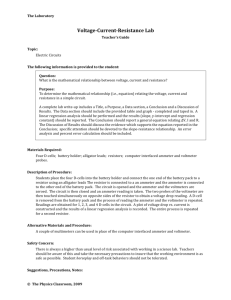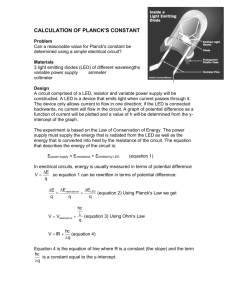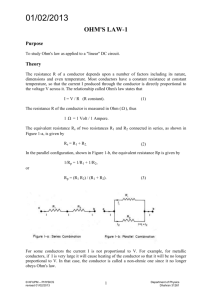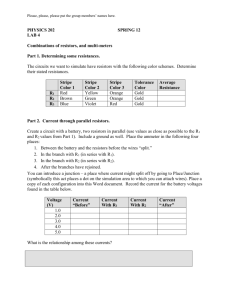Combinations of resistors and non-ideal meters
advertisement
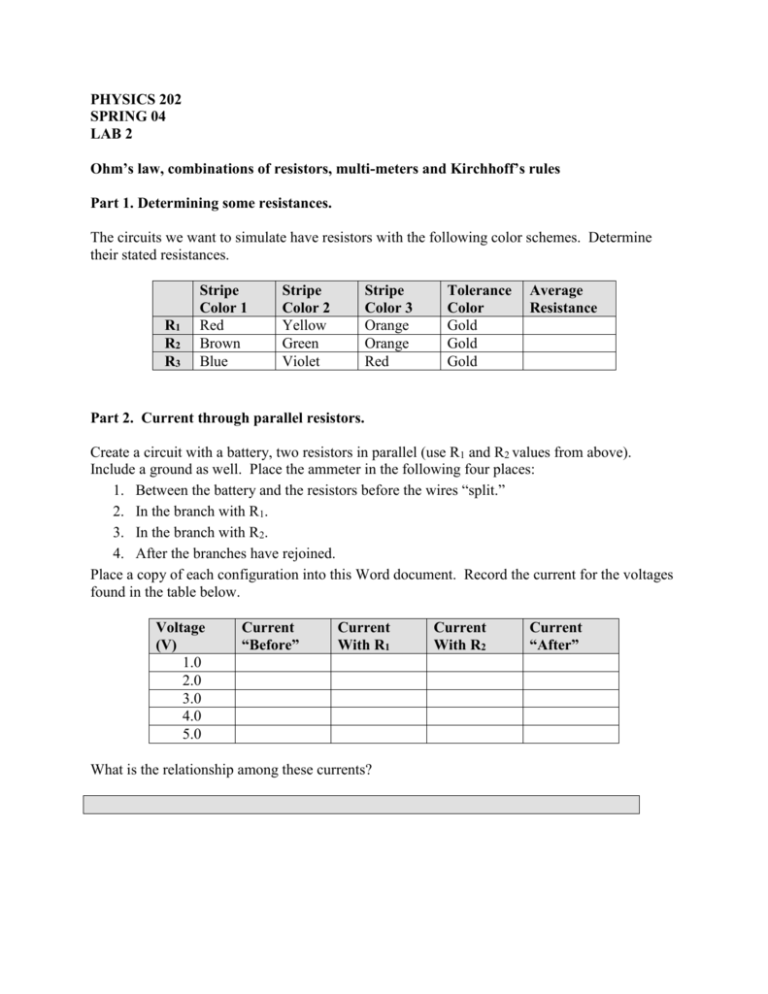
PHYSICS 202 SPRING 04 LAB 2 Ohm’s law, combinations of resistors, multi-meters and Kirchhoff’s rules Part 1. Determining some resistances. The circuits we want to simulate have resistors with the following color schemes. Determine their stated resistances. R1 R2 R3 Stripe Color 1 Red Brown Blue Stripe Color 2 Yellow Green Violet Stripe Color 3 Orange Orange Red Tolerance Color Gold Gold Gold Average Resistance Part 2. Current through parallel resistors. Create a circuit with a battery, two resistors in parallel (use R1 and R2 values from above). Include a ground as well. Place the ammeter in the following four places: 1. Between the battery and the resistors before the wires “split.” 2. In the branch with R1. 3. In the branch with R2. 4. After the branches have rejoined. Place a copy of each configuration into this Word document. Record the current for the voltages found in the table below. Voltage (V) 1.0 2.0 3.0 4.0 5.0 Current “Before” Current With R1 What is the relationship among these currents? Current With R2 Current “After” Part 3. Voltmeter 1. Simulate a circuit with R1 and R3 (use the values from above) in series and that combination in parallel with R2. Connect that entire combination to a battery and include a ground. 2. Place a voltmeter (under Indicators) across R1 and record the voltmeter reading for the battery voltages found in the table below. Make sure your voltmeter is in DC mode. 3. Place the voltmeter across R2 and repeat. 4. Place the voltmeter across R3 and repeat. 5. Place a copy of one of the above configurations over to this Word document. Voltage Supplied (V) Voltage across R1 Voltage across R2 Voltage across R3 1.0 2.0 3.0 4.0 5.0 What is the relationship between these voltages? Part 4. Equivalent resistance. What is the equivalent resistance Req of the combinations shown below, that is, what single resistor would draw the same current as these combinations if the combination were connected to battery at points A and B? How did you arrive at your answer? Resistance of first combination = How? Resistance of second combination = How? Part 5. A non-ideal ammeter. Recall that to measure the current passing through a given resistor, you place an ammeter in series with it. The resistance of the ammeter should be small so that it does not change significantly the current through the resistor (and hence the voltage drop across the resistor). Create a circuit consisting of a battery (10 V), a resistor (10 k), an ammeter (in series with the resistor) and a ground. Note that under the ammeter’s Component Properties (under the Values tab) there is a resistance that you can change. This is the “internal” resistance of the ammeter. The default value is quite small which makes the ammeter “ideal.” Increase the resistance until your ammeter reading changes by approximately 0.1% from the ideal reading. Repeat for changes of 1% and 10%. Place the value of the internal resistance of the ammeter in the table below. Place a copy of your circuit below. Percentage of current change from the ideal 0.1% 1.0% 10% Ammeter’s internal resistance Part 6. A non-ideal voltmeter. Recall that to measure the voltage drop across a given resistor, you place a voltmeter in parallel with it. The resistance of the voltmeter should be large so that it does not change significantly the current through the resistor (and in turn the voltage drop across the resistor). Create a circuit consisting of a battery (10 V), two resistors (5 k each) in series, a voltmeter (across one resistor) and a ground. Note that under the voltmeter’s Component Properties (under the Values tab) there is a resistance that you can change. This is the “internal” resistance of the voltmeter. The default value is quite large which makes the voltmeter “ideal.” Decrease the resistance until your voltmeter reading changes by approximately 0.1% from the ideal reading. Repeat for changes of 1% and 10%. Place the value of the internal resistance of the voltmeter in the table below. Place a copy of your circuit below. Percentage of voltage change from the ideal 0.1% Voltmeter’s internal resistance 1.0% 10% Part 7. Combination of resistors and Kirchhoff’s Rules Note: Remember to look for simple series and parallel combinations to simplify your circuit before beginning the more complicated procedure required for more complex circuits. Using theory (equations), find the current passing through each resistor below. Then simulate the circuit in Electronics Workbench and verify your results. The solving equations part of your report can be hand written. If you use Kirchhoff’s rules, draw the circuit, explicitly assign currents on your circuit, draw the loops you use in applying Kirchhoff’s rules, write down the resulting equations, show the algebra, etc. Print out a copy of the circuit with a meter reading out at least one of the desired results to include in your report. For the circuit below use theory (equations) to find the current passing through the 1.7-k resistor (below) as well as the voltage drop across the 3.3-k resistor. Then simulate the circuit in Electronics Workbench and verify your results. Print out a copy of the circuit with a meter reading out at least one of the desired results to include in your report. Part 8. Some questions. Search the web and find some information on surge protectors. Print out a page listing some of the specifications. Search the web and find some information on UPSs. Print out a page listing some of the specifications.

